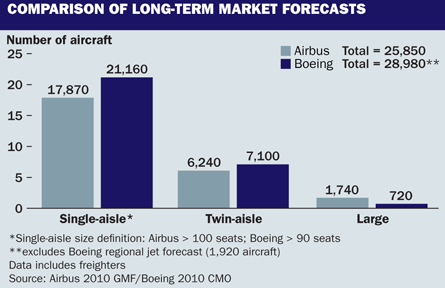Airbus has been more restrained than Boeing with the growth of its latest long-term airliner delivery forecast, but remains extremely bullish about the very large airliner (VLA) market. It attributes the significant deficit to its rival in terms of delivery volume to its expectation that rapid traffic growth will create a major shift to higher-capacity aircraft.
Airbus has increased its forecast for deliveries over the next 20 years by around 1,000 aircraft, or 3.6%, from 24,950 aircraft in its 2009 Global Market Forecast (GMF) to 25,850 (including 870 freighters) this year. It values these deliveries at $3.2 trillion, compared with $3.1 trillion in its last GMF, published in September 2009.
In contrast, Boeing's 2010 Current Market Outlook, published in July, rose by 1,900 units, or 7.7%, to 28,980 aircraft (excluding regional jets), from 26,900 in the 2009 edition.
The Airbus and Boeing rises have been driven largely by increases in the forecast for single-aisle deliveries - 1,000 units for Airbus and 1,700 for Boeing.
 |
|---|
"Last year we had forecast 4.7% annual traffic growth, but we've bumped it up to 4.8%, which can explain around 150 of the 1,000 aircraft rise," says Chris Emerson, who is Airbus senior vice-president market and product strategy. "The remaining 750 is down to two effects: another year of ordering, plus we've taken out a year of the downturn. There is the 'bump-up' of a stronger year because a bad downturn-year is eliminated."
Boeing attributed its rise to three factors: an increase its outlook for annual world economy growth (from 3.1% to 3.2%); greater demand for replacement aircraft; and the increasing influence of low-cost carriers.
While Boeing also added 400 aircraft to its twin-aisle demand forecast this year, Airbus's view of this sector remains unchanged because the revision to its traffic-growth projection since last year's GMF is too small to affect the larger categories, says Emerson. "Traffic growth - unless it is greater than one per cent - may add some seats but is hard to translate that into actual aircraft in the larger categories. But when you talk about single-aisles, you start adding aircraft," he says.
While the bulk of the demand in both manufacturers' forecasts is for single-aisles, Boeing sees demand for more than 3,000 more aircraft than its rival in this category, and it's not all down to the fact that its total includes some large regional jets, says Emerson.
"Boeing's single-aisle category includes 90-seaters such as Embraer E-Jets and large CRJs, whereas we are at 100 seats and above," he says.
"The other big driver is how we view the capacity/frequency question. We see in the emerging regions with their population density that they need to go to bigger aircraft. So we see traffic accommodated in the VLA market, where as Boeing sees it being accommodated more in the twin sector."
Airbus's latest GMF puts demand in the VLA sector at 1,740 aircraft (including more than 400 freighters). This is consistent with last year's forecast and again contrasts dramatically with Boeing's pessimistic view of the VLA market. The US airframer said earlier this year that the Airbus forecast needed "a paradigm shift in the marketplace", and forecasts less than half of the VLA demand that Airbus does - 720 aircraft, including 220 freighters.
But Airbus's chief salesman, John Leahy, believes that the rapid traffic-growth forecast in the emerging market can only be achieved by airlines moving to larger aircraft: "If traffic is going to double every 15 years, on average, how are we going to accommodate that when many airports are already reaching limits of their growth?" he asks.
"Are we just going to throw twice as many airplanes into markets that are already saturated? That's impossible. The only way we can handle this is by having an increase in the average size of the aircraft, moving up into aircraft like the A350 and the A380."
Airbus is confident that long-term traffic growth will see a dramatic rise in "aviation mega-cities" (ie those with more than five billion revenue passenger kms annually) over the next 20 years, creating a series of VLA hubs around the world.
Emerson says that because Airbus sees greater demand than its rival for large aircraft, it shifts seats from the smaller categories, resulting in the triple-digit difference between the overall forecasts, in unit terms. "But if you were to compare on a total-seat basis over the next 20 years, we are within plus/minus 5% of each other," he says.
Source: Flight International
















